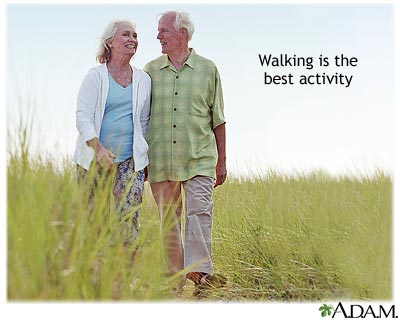Being active after your heart attack
Heart attack - activity; MI - activity; Myocardial infarction - activity; Cardiac rehabilitation - activity; ACS - activity; NSTEMI - activity; Acute coronary syndrome activity

A prescription for physical activity is important after a heart attack. It is important to follow the guidelines for physical activity from your clinical team. Start slowly, and increase the amount of time you exercise gradually.
When You're in the Hospital
You had a heart attack and were in the hospital. You may have had angioplasty and a stent placed in an artery to open a blocked artery in your heart.
What to Expect at Home
While you were in the hospital, you should have learned:
- How to take your pulse.
- How to recognize your angina symptoms and what to do when they happen.
- How to care for yourself at home after a heart attack.
Your health care provider may recommend a cardiac rehabilitation program to you. This program will help you learn what foods to eat and exercises to do to stay healthy. Eating well and exercising will help you start feeling healthy again.
Getting Started with Your Exercise
Before you start to exercise, your provider may have you do an exercise test or complete a cardiac rehabilitation program. You should get exercise recommendations and an exercise plan. This may happen before you leave the hospital or soon afterward. Do not change your exercise plan before talking with your provider. The amount and intensity of your activity will depend on how active you were before the heart attack and how severe your heart attack was.
Take it easy at first:
- Walking is the best activity when you start exercising.
- Walk on flat ground for a few weeks at first.
- You can try bike riding after a few weeks.
- Talk to your providers about a safe level of exertion.
Slowly increase how long you exercise at any one time. If you are up to it, repeat the activity 2 or 3 times during the day. You may want to try this very easy exercise schedule (but ask your provider first):
- Week 1: about 5 minutes at a time
- Week 2: about 10 minutes at a time
- Week 3: about 15 minutes at a time
- Week 4: about 20 minutes at a time
- Week 5: about 25 minutes at a time
- Week 6: about 30 minutes at a time
After 6 weeks, you may be able to start swimming, but stay out of very cold or very hot water. You can also begin playing golf. Start easily with just hitting balls. Add to your golfing slowly, playing just a few holes at a time. Avoid golfing in very hot or cold weather.
Household Activities
You can do some things around the house to stay active, but always ask your provider first. Avoid a lot of activity on days that are very hot or cold. Some people will be able to do more after a heart attack. Others may have to start more slowly. Increase your activity level gradually by following these steps.
You may be able to cook light meals by the end of your first week. You can wash dishes or set the table if you feel up to it.
By the end of the second week you may start doing very light housework, such as making your bed. Go slowly.
After 4 weeks, you may be able to:
- Iron -- start with only 5 or 10 minutes at a time
- Shop, but do not carry heavy bags or walk too far
- Do short periods of light yard work
By 6 weeks, your provider may allow you to do more activities, such as heavier housework and exercise, but be careful.
- Try not to lift or carry anything that is heavy, such as a vacuum cleaner or pail of water.
- If any activities cause chest pain, shortness of breath, or any of the symptoms you had before or during your heart attack, stop doing them right away. Tell your provider.
When to Call the Doctor
Contact your provider if you feel:
- Pain, pressure, tightness, or heaviness in the chest, arm, neck, or jaw
- Shortness of breath
- Gas pains or indigestion
- Numbness in your arms
- Sweaty, or if you lose color
- Lightheaded
Also contact your provider if you have angina and it:
- Becomes stronger
- Occurs more often
- Lasts longer
- Occurs when you are not active
- Does not get better when you take your medicine
These changes may mean your heart disease is getting worse.
References
Boden WE. Angina pectoris and chronic ischemic heart disease. In: Goldman L, Cooney KA, eds. Goldman-Cecil Medicine. 27th ed. Philadelphia, PA: Elsevier; 2024:chap 56.
Bohula EA, Morrow DA. ST-elevation myocardial infarction: management. In: Libby P, Bonow RO, Mann DL, Tomaselli GF, Bhatt DL, Solomon SD, eds. Braunwald's Heart Disease: A Textbook of Cardiovascular Medicine. 12th ed. Philadelphia, PA: Elsevier; 2022:chap 38.
Giugliano RP, Braunwald E. Non-ST elevation acute coronary syndromes. In: Libby P, Bonow RO, Mann DL, Tomaselli GF, Bhatt DL, Solomon SD, eds. Braunwald's Heart Disease: A Textbook of Cardiovascular Medicine. 12th ed. Philadelphia, PA: Elsevier; 2022:chap 39.
Morrow DA, de Lemos J. Stable ischemic heart disease. In: Libby P, Bonow RO, Mann DL, Tomaselli GF, Bhatt DL, Solomon SD, eds. Braunwald's Heart Disease: A Textbook of Cardiovascular Medicine. 12th ed. Philadelphia, PA: Elsevier; 2022:chap 40.
Thomas RJ. Comprehensive cardiac rehabilitation. In: Libby P, Bonow RO, Mann DL, Tomaselli GF, Bhatt DL, Solomon SD, eds. Braunwald's Heart Disease: A Textbook of Cardiovascular Medicine. 12th ed. Philadelphia, PA: Elsevier; 2022:chap 33.
Version Info
Last reviewed on: 8/5/2024
Reviewed by: Thomas S. Metkus, MD, Assistant Professor of Medicine and Surgery, Johns Hopkins University School of Medicine, Baltimore, MD. Also reviewed by David C. Dugdale, MD, Medical Director, Brenda Conaway, Editorial Director, and the A.D.A.M. Editorial team.
